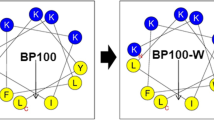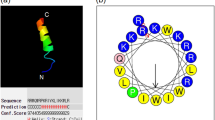Abstract
The poor stability of peptides against trypsin largely limits their development as potential antibacterial agents. Here, to obtain a peptide with increased trypsin stability and potent antibacterial activity, TICbf-14 derived from the cationic peptide Cbf-14 was designed by the addition of disulfide-bridged hendecapeptide (CWTKSIPPKPC) loop. Subsequently, the trypsin stability and antimicrobial and antibiofilm activities of this peptide were evaluated. The possible mechanisms underlying its mode of action were also clarified. The results showed that TICbf-14 exhibited elevated trypsin inhibitory activity and effectively mitigated lung histopathological damage in bacteria-infected mice by reducing the bacterial counts, further inhibiting the systemic dissemination of bacteria and host inflammation. Additionally, TICbf-14 significantly repressed bacterial swimming motility and notably inhibited biofilm formation. Considering the mode of action, we observed that TICbf-14 exhibited a potent membrane-disruptive mechanism, which was attributable to its destructive effect on ionic bridges between divalent cations and LPS of the bacterial membrane. Overall, TICbf-14, a bifunctional peptide with both antimicrobial and trypsin inhibitory activity, is highly likely to become an ideal candidate for drug development against bacteria.
Similar content being viewed by others
References
Alakomi, H.L., Paananen, A., Suihko, M.L., Helander, I.M., and Saarela, M. 2006. Weakening effect of cell permeabilizers on Gram-negative bacteria causing biodeterioration. Appl. Environ. Microbiol. 72, 4695–4703.
Bechinger, B. and Gorr, S.U. 2017. Antimicrobial peptides: mechanisms of action and resistance. J. Dent. Res. 96, 254–260.
Bessa, L.J., Eaton, P., Dematei, A., Plácido, A., Vale, N., Gomes, P., Delerue-Matos, C., Sa Leite, J.R., and Gameiro, P. 2018. Synergistic and antibiofilm properties of ocellatin peptides against multidrug-resistant Pseudomonas aeruginosa. Future Microbiol. 13, 151–163.
Bhunia, A., Mohanram, H., Domadia, P.N., Torres, J., and Bhattacharjya, S. 2009. Designed β-boomerang antiendotoxic and antimicrobial peptides: structures and activities in lipopolysaccharide. J. Biol. Chem. 284, 21991–22004.
Cerqueira, D.M., Gomes, M.T.R., Silva, A.L.N., Rungue, M., Assis, N.R.G., Guimarães, E.S., Morais, S.B., Broz, P., Zamboni, D.S., and Oliveira, S.C. 2018. Guanylate-binding protein 5 licenses caspase-11 for Gasdermin-D mediated host resistance to Brucella abortus infection. PLoS Pathog. 14, e1007519.
de Breij, A., Riool, M., Cordfunke, R.A., Malanovic, N., de Boer, L., Koning, R.I., Ravensbergen, E., Franken, M., van der Heijde, T., Boekema, B.K., et al. 2018. The antimicrobial peptide SAAP-148 combats drug-resistant bacteria and biofilms. Sci. Transl. Med. 10, eaan4044.
Domhan, C., Uhl, P., Kleist, C., Zimmermann, S., Umstätter, F., Leotta, K., Mier, W., and Wink, M. 2019. Replacement of L-amino acids by D-amino acids in the antimicrobial peptide ranalexin and its consequences for antimicrobial activity and biodistribution. Molecules 24, 2987.
Dong, W., Mao, X., Guan, Y., Kang, Y., and Shang, D. 2017. Antimicrobial and anti-inflammatory activities of three chensinin-1 peptides containing mutation of glycine and histidine residues. Sci. Rep. 7, 40228.
Edwards-Gayle, C.J.C., Barrett, G., Roy, S., Castelletto, V., Seitsonen, J., Ruokolainen, J., and Hamley, I.W. 2020. Selective antibacterial activity and lipid membrane interactions of arginine-rich amphiphilic peptides. ACS Appl. Bio Mater. 3, 1165–1175.
Farha, M.A., Verschoor, C.P., Bowdish, D., and Brown, E.D. 2013. Collapsing the proton motive force to identify synergistic combinations against Staphylococcus aureus. Chem. Biol. 20, 1168–1178.
Indarte, M., Lazza, C.M., Assis, D., Caffini, N.O., Juliano, M.A., Avilés, F.X., Daura, X., López, L.M.I., and Trejo, S.A. 2017. A Bowman-Birk protease inhibitor purified, cloned, sequenced and characterized from the seeds of Maclura pomifera (Raf.) Schneid. Planta 245, 343–353.
Juliano, S.A., Pierce, S., deMayo, J.A., Balunas, M.J., and Angeles-Boza, A.M. 2017. Exploration of the innate immune system of Styela clava: Zn2+ binding enhances the antimicrobial activity of the tunicate peptide Clavanin A. Biochemistry 56, 1403–1414.
Karstad, R., Isaksen, G., Wynendaele, E., Guttormsen, Y., De Spiegeleer, B., Brandsdal, B.O., Svendsen, J.S., and Svenson, J. 2012. Targeting the S1 and S3 subsite of trypsin with unnatural cationic amino acids generates antimicrobial peptides with potential for oral administration. J. Med. Chem. 55, 6294–6305.
Kerenga, B.K., McKenna, J.A., Harvey, P.J., Quimbar, P., Garcia-Ceron, D., Lay, F.T., Phan, T.K., Veneer, P.K., Vasa, S., Parisi, K., et al. 2019. Salt-tolerant antifungal and antibacterial activities of the corn defensin ZmD32. Front. Microbiol. 10, 795.
Lazzaro, B.P., Zasloff, M., and Rolff, J. 2020. Antimicrobial peptides: application informed by evolution. Science 368, eaau5480.
Li, J., Cheng, Z., Xu, X., Wang, J., Yu, H., Lai, R., and Gong, W. 2007. Trypsin inhibitory loop is an excellent lead structure to design serine protease inhibitors and antimicrobial peptides. FASEB J. 21, 2466–2473.
Lyu, Y., Chen, T., Shang, L., Yang, Y., Li, Z., Zhu, J., and Shan, A. 2019. Design of Trp-rich dodecapeptides with broad-spectrum antimicrobial potency and membrane-disruptive mechanism. J. Med. Chem. 62, 6941–6957.
Ma, B., Fang, C., Lu, L., Wang, M., Xue, X., Zhou, Y., Li, M., Hu, Y., Luo, X., and Hou, Z. 2019. The antimicrobial peptide thanatin disrupts the bacterial outer membrane and inactivates the NDM-1 metallo-β-lactamase. Nat. Commun. 10, 3517.
Ma, L., Wang, Y., Wang, M., Tian, Y., Kang, W., Liu, H., Wang, H., Dou, J., and Zhou, C. 2016. Effective antimicrobial activity of Cbf-14, derived from a cathelin-like domain, against penicillin-resistant bacteria. Biomaterials 87, 32–45.
Ma, L., Wei, S., Ye, X., Xu, P., Chen, H., Liu, Z., and Zhou, C. 2020a. Antifungal activity of peptide MSI-1 against Cryptococcus neoformans infection in vitro and in murine cryptococcal meningoencephalitis. Peptides 130, 170334.
Ma, L., Xie, X., Liu, H., Huang, Y., Wu, H., Jiang, M., Xu, P., Ye, X., and Zhou, C. 2020b. Potent antibacterial activity of MSI-1 derived from the magainin 2 peptide against drug-resistant bacteria. Theranostics 10, 1373–1390.
Ma, L., Ye, X., Sun, P., Xu, P., Wang, L., Liu, Z., Huang, X., Bai, Z., and Zhou, C. 2020c. Antimicrobial and antibiofilm activity of the EeCentrocin 1 derived peptide EC1–17KV via membrane disruption. EBioMedicine 55, 102775.
Malik, E., Dennison, S.R., Harris, F., and Phoenix, D.A. 2016. pH dependent antimicrobial peptides and proteins, their mechanisms of action and potential as therapeutic agents. Pharmaceuticals 9, 67.
Miao, Y., Chen, G., Xi, X., Ma, C., Wang, L., Burrows, J.F., Duan, J., Zhou, M., and Chen, T. 2019. Discovery and rational design of a novel Bowman-Birk related protease inhibitor. Biomolecules 9, 280.
Pariani, S., Contreras, M., Rossi, F.R., Sander, V., Corigliano, M.G., Simón, F., Busi, M.V., Gomez-Casati, D.F., Pieckenstain, F.L., Duschak, V.G., et al. 2016. Characterization of a novel Kazal-type serine proteinase inhibitor of Arabidopsis thaliana. Biochimie 123, 85–94.
Persson, L.J.P., Aanerud, M., Hardie, J.A., Miodini Nilsen, R., Bakke, P.S., Eagan, T.M., and Hiemstra, P.S. 2017. Antimicrobial peptide levels are linked to airway inflammation, bacterial colonisation and exacerbations in chronic obstructive pulmonary disease. Eur. Respir. J. 49, 1600328.
Rathinam, V.A.K., Vanaja, S.K., Waggoner, L., Sokolovska, A., Becker, C., Stuart, L.M., Leong, J.M., and Fitzgerald, K.A. 2012. TRIF licenses caspase-11-dependent NLRP3 inflammasome activation by Gram-negative bacteria. Cell 150, 606–619.
Siddiqui, I., Husain, Q., and Azam, A. 2020. Exploring the antioxidant effects of peptides from almond proteins using PAni-Ag-GONC conjugated trypsin by improving enzyme stability & applications. Int. J. Biol. Macromol. 158, 150–158.
Souza, P.F.N., Marques, L.S.M., Oliveira, J.T.A., Lima, P.G., Dias, L.P., Neto, N.A.S., Lopes, F.E.S., Sousa, J.S., Silva, A.F.B., Caneiro, R.F., et al. 2020. Synthetic antimicrobial peptides: from choice of the best sequences to action mechanisms. Biochimie 175, 132–145.
Wadhwani, P., Heidenreich, N., Podeyn, B., Bürck, J., and Ulrich, A.S. 2017. Antibiotic gold: tethering of antimicrobial peptides to gold nanoparticles maintains conformational flexibility of peptides and improves trypsin susceptibility. Biomater. Sci. 5, 817–827.
Wang, M., Lin, J., Sun, Q., Zheng, K., Ma, Y., and Wang, J. 2019. Design, expression, and characterization of a novel cecropin A-derived peptide with high antibacterial activity. Appl. Microbiol. Biotechnol. 103, 1765–1775.
Yu, H., Wang, C., Feng, L., Cai, S., Liu, X., Qiao, X., Shi, N., Wang, H., and Wang, Y. 2017. Cathelicidin-trypsin inhibitor loop conjugate represents a promising antibiotic candidate with protease stability. Sci. Rep. 7, 2600.
Yu, H., Wang, Y., Zeng, X., Cai, S., Wang, G., Liu, L., Huang, S., Li, N., Liu, H., Ding, X., et al. 2020. Therapeutic administration of the recombinant antimicrobial peptide microcin J25 effectively enhances host defenses against gut inflammation and epithelial barrier injury induced by enterotoxigenic Escherichia coli infection. FASEB J. 34, 1018–1037.
Zhong, C., Liu, T., Gou, S., He, Y., Zhu, N., Zhu, Y., Wang, L., Liu, H., Zhang, Y., Yao, J., et al. 2019. Design and synthesis of new N-terminal fatty acid modified-antimicrobial peptide analogues with potent in vitro biological activity. Eur. J. Med. Chem. 182, 111636.
Acknowledgements
This work was funded by the National Key Research and Development ProGram of China (2018YFA0902000); National Natural Science Foundation of China (No.82173863; No.81803591); the fellowship of china postdoctoral science foundation (2020T130723); Natural Science Foundation of Jiangsu Province of China (No. BK20180563; No. BK2020-1327); the Basic Scientific Research Business Expense Project of China Pharmaceutical University (No. 2632021ZD07). Youth Science and Technology Talent Support Project of Jiangsu Association for Science and Technology (tj1288).
Author information
Authors and Affiliations
Contributions
Changlin Zhou and Lingman Ma designed research; Liping Wang performed the experiments and edited the manuscript; Xiaoyun Liu, Xinyue Ye, Chenyu Zhou, Wenxuan Zhao contributed new methods; Changlin Zhou and Lingman Ma provided funding sources. All authors read and approved the manuscript.
Corresponding authors
Additional information
Conflict of Interest
All authors declare that they have no conflicts of interest.
Rights and permissions
About this article
Cite this article
Wang, L., Liu, X., Ye, X. et al. Potent antibacterial and antibiofilm activities of TICbf-14, a peptide with increased stability against trypsin. J Microbiol. 60, 89–99 (2022). https://doi.org/10.1007/s12275-022-1368-9
Received:
Revised:
Accepted:
Published:
Issue Date:
DOI: https://doi.org/10.1007/s12275-022-1368-9




